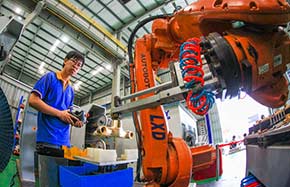How Belt and Road can be 'future-proofed'
There are many reasons why China is pursuing the Belt and Road Initiative. However, one of the least discussed-but perhaps most significant-is related to population.
Readers of China Daily will be familiar with the demographic challenges China is likely to face in the next decades. A rapidly aging population, coupled with the drying up of surplus rural workforce, means China's status as the "factory of the world" is under grave threat.
One thing which almost all of the countries involved in the Silk Road Economic Belt and the 21st Century Maritime Silk Road have in common is demographic conditions that are favorable to rapid industrial growth. Along with a large, young working-age population, the potential for economic growth is multiplied by the majority of current jobs being in low-productivity areas such as agriculture or informal, family work. Indeed, a transition toward "decent employment" with social and job security, rights and other requirements would be truly a welcome development.
Clearly, a strategic element of the Belt and Road Initiative is for Chinese companies to harness this demographic potential in countries involved in the Belt and Road Initiative as a response to the challenges at home.
Courtesy of US President Donald Trump, globalization has, in recent months, become a dirty word. However, it is important to remember that for many years, the concept has attracted many critics. Much of this criticism relates to the exploitation of workers around the world by countries and corporations which, in the search for maximum profits, perform a kind of "race to the bottom" in terms of wages and rights. In this vein, like a plague of locusts, companies set up shops, bleed a country dry, and then pack up and move on to the next place. There is little or no "value-added", merely exploitation.
There are, I'm sure, many who fear that this brand of 20th century globalization might lie at the heart of the Belt and Road Initiative.
But, as China knows very well, favorable demographic circumstances for a certain kind of industrial strategy are but a fleeting phenomenon. Looking 20 or so years down the line, if the Belt and Road Initiative is truly successful, then the favorable demographic circumstances will very quickly change. This is due to the close link between industrial growth, job opportunities and falling fertility. In other words, most of the countries involved in the Belt and Road Initiative in the future will, demographically speaking, be like the China of today. How, then, can China attempt to "demographically future-proof" the initiative?
It is possible to develop very liberal migration policies which would constantly replenish the population in a way which would never be considered acceptable in China itself. Industries in the countries involved in the Belt and Road Initiative, then, could become "hubs" for regional migration. While perhaps effective in the short- to medium-term, the economic, social, political and cultural sustainability of this model is certainly up for question.
I would argue that in order to make the infrastructure investment worthwhile, and the growth sustainable, investing in developing education, skills and training is critical. This would create a more flexible, productive workforce which would be able to move up the value chain of innovation in the future.
Such a policy would also have other consequences. Now that the United States has pulled out of the Paris climate change agreement, China could further demonstrate its green credentials. We know that education is linked to improved awareness of environmental issues as well as climate change mitigation.
There are, for sure, many workers in need of jobs in the countries involved in the Belt and Road Initiative. Chinese employers can either be "bad" employers interested only in the bottom line, or "good" ones. As well as being more "demographically future-proofed", we also know that "good" employers who provide decent employment with protections, rights, training and other elements are generally rewarded with happier employees, higher productivity, improved retention and success in recruitment. China could be the ultimate "good employer". An example for countries, corporations as well as other businesses around the world that a better globalization can be set.
The author is visiting associate professor of Social Sciences at the Hong Kong University of Science and Technology.





















